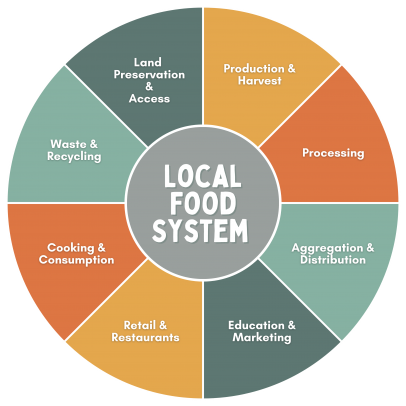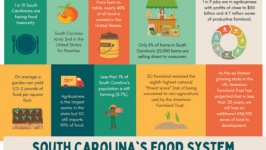The Secret Ingredient of Local Food Systems: People
“When we talk about food systems, it doesn’t start when we break the ground and plant a seed. It starts with the landscapes we find ourselves on. We don’t think about it but we are surrounded by food,” DeLesslin “Roo” George-Warren says, referencing the wealth of wild plants, mushrooms, animals and herbs in the natural environment.
Reflecting on the disconnect society faces with food, including within the Catawba Indian Nation, George-Warren notes, “One of our biggest issues is the loss of knowledge including how to find it, take care of it, not take too much and how to prepare it.”
For Indigenous people across the world, this erosion of knowledge is directly tied to the loss of traditional lands, the systematic dismantling and displacement of communities and the federal control over commodity foods distributed into Native communities.
During the Indigenous Leaders caucus at the 2022 Growing Local SC Food Summit, participants prioritized “food sovereignty” as the number one goal.
Food sovereignty can be defined as a community having the right to control its own food system, farm to table. This concept resonated with participants, tying for fourth as one of the top opportunities for South Carolina’s food system. Discussions repeatedly circled around how much potential the state has to feed its communities while supporting its farmers and food system workers.
“One of my hopes is that a decade from now we enact the ethic that everyone gets food, everyone gets water and has shelter,” George-Warren says.
These aspirations are as practical and realistic as they are ambitious and complex. As noted in the previous two articles of this series, the dominant food systems in America are part of a globalized system that prioritizes efficiency, convenience and money above all else. While many lived blissfully unaware of the true cost of this broken system, the pandemic pulled the curtains back to reveal a stark reality.
The existing systems have come at the expense of human lives, health and safety, equity, and caused environmental degradation, the erosion of local economies, rural blight, etc. And even with all of these staggering indirect costs, this system does not provide access to healthy or affordable food to almost 20% of the nation’s population. The negative impacts, inequities and inaccessibility of the food system have incited incredible momentum towards rebuilding of food systems to serve communities instead of corporations. The local foods movement continues to rise in response to global supply chains and instead offers alternatives such as “values-based supply chains,” “local food supply chains,” “foodsheds” and “community food webs”.
What are the ingredients of a local food system? To start, we can explore the core sectors of a local food system, which are typically broken down into the following categories:
- Land preservation + access
- Production + Harvest
- Processing
- Aggregation + Distribution
- Education + Marketing
- Retail + Restaurants
- Cooking + Consumption
- Waste + Recycling
The South Carolina Food Policy Council is working to bring these sectors together to cross-pollinate and build a bridge between the local and state level. To support individuals and organizations in connecting around local food system issues, the Council facilitates open meetings, provides assistance to 11 local food policy councils and supports cross-sector initiatives like Food is Medicine and Growing Local SC.
In Marion County, where approximately one in four residents lives in poverty, Pick 42 Foundation (Neighbors Helping Neighbors) became a hub that adapted from day to day. Executive Director Miko Pickett was able to tap into her strong grassroots network to both understand the needs of the community and bring in the right partners to help them get through the pandemic. From vaccine clinics to emergency food relief, the organization evolved weekly to meet community needs. As the emergency aid started to dwindle, Pickett quickly began seeking local, sustainable solutions to ensure residents had food access in the long-term. Before long, Pickett began working with local partners to plant a community garden and started reaching out to local farmers.
Through this journey Pickett was introduced to the Council and several years later, now serves as the board chair. Pick 42’s programs have grown to include a mobile food pantry, five community gardens, the Marion County Food Policy Council and the “Eat Local Pee Dee” Black farmer network.
“The seasons are longer here, the soil is fertile, and our farmers know how to grow…we just want to help them succeed as farm businesses,” Pickett says.
Pickett is the “leadership” factor in the Marion local food system that connects the needs of the local community all the way to leadership at the state level. She became a food system leader out of necessity in order to feed her community despite having no formal training in the sector. Instead, Pickett leveraged her years working in corporate technology and her strong network-building skills to recruit the right partners to serve the community.
The majority of the food system leaders in the network were also forged in the fires of trial-and-error, sharing a passion for community and a tireless commitment to finding solutions. Based on the success of local leaders like Pickett working to rebuild their food system one relationship at a time, it is clear that our dynamic and complex systems need dynamic and diverse leadership from all backgrounds. Formally trained or self-taught, this movement cannot be sustained without on-the-ground food system leaders and their place-based solutions gaining the recognition, support and investment necessary.
Pickett and George-Warren's story are two of hundreds across the state. We have an abundance of data and stories about the local innovation, donations collected, farms saved and people fed to prove what we’ve championed all along: resilience is found in place- based solutions driven by local leadership and supported by strong networks built on trust. Whether this translates into long-term, systemic support for these efforts remains to be seen.
As federal funding continues to rain down, there has never been a more important time for state leadership to recognize the value of investing in local food systems. The return on investment could mean a pathway toward resilience for agriculture, increased food access, improved health outcomes, an economic development tool for rural communities, control of our own food supply, workforce development, natural resource conservation, increased tourism and an opportunity for collaboration across political lines.
Creating meaningful systems change takes a groundswell of support with every county in the state engaged in local networks with direct connections at the state level. Together this network can channel the on-the-ground needs into a state-level platform, creating the potential to reach the overarching goal: food sovereignty.








